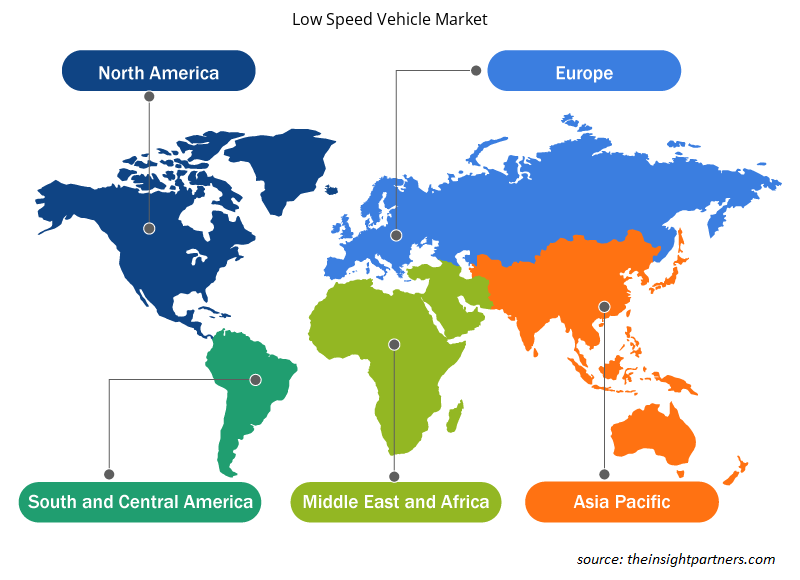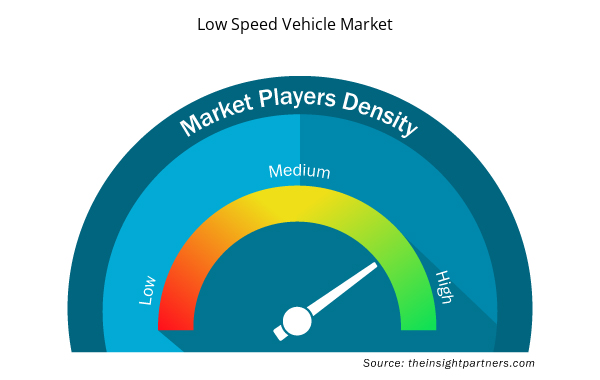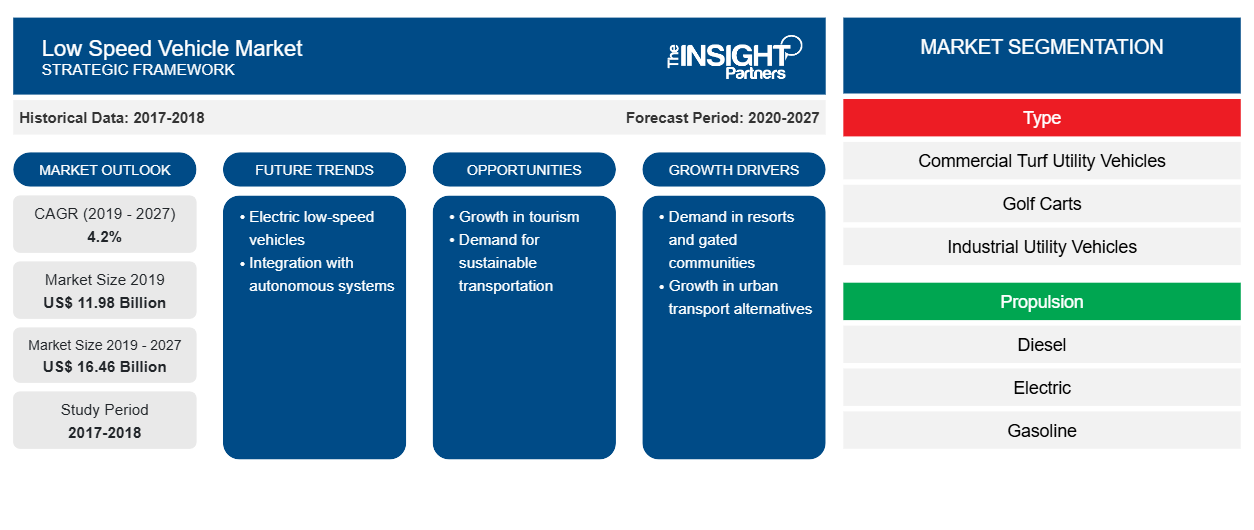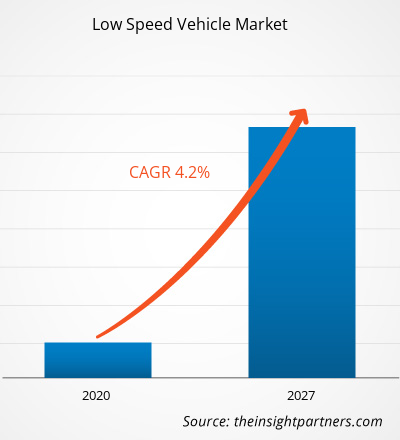Der Markt für langsame Fahrzeuge hatte im Jahr 2019 einen Wert von 11,98 Milliarden US-Dollar und dürfte von 2020 bis 2027 mit einer durchschnittlichen jährlichen Wachstumsrate von 4,2 % wachsen und bis 2027 einen Wert von 16,46 Milliarden US-Dollar erreichen.
Der Markt für langsame Fahrzeuge hat in den letzten Jahren weltweit ein enormes Wachstum erlebt. Die positiven Wirtschaftsaussichten, steigende verfügbare Einkommen und die wachsende Bevölkerung sind einige der Faktoren, die die Nachfrage nach Infrastrukturprojekten antreiben. Aufgrund des hohen Volumens an Online-Bestellungen wächst auch die E-Commerce-Branche, was zu mehr Lagerhäusern in der Region führen würde. Langsame Fahrzeuge im Lager helfen dabei, die Kisten von einem Ort zum anderen zu bewegen. Die oben genannten Faktoren spielen eine wichtige Rolle bei der Beschleunigung des Wachstums des Marktes für langsame Fahrzeuge . Die Region APAC hatte 2019 den größten Marktanteil und wird voraussichtlich die am schnellsten wachsende Region auf dem Markt für langsame Fahrzeuge sein. Nordamerika und Europa sind die zweit- und drittgrößte Region auf dem Markt für langsame Fahrzeuge.
Der Ausbruch des Coronavirus begann im Dezember 2019 in Wuhan (China). Er hat sich in rasantem Tempo auf der ganzen Welt verbreitet und zu den am schlimmsten betroffenen Ländern zählen China, Italien, Iran, Spanien, die Republik Korea, Frankreich, Deutschland und die USA. Der Ausbruch von COVID-19 und seine daraus resultierenden Auswirkungen wie Grenzschließungen , Shutdowns und Reiseverbote haben begonnen, sich auf Unternehmen in verschiedenen Branchen auszuwirken. Der Markt für langsame Fahrzeuge wird aufgrund der Unterbrechungen der globalen Lieferketten voraussichtlich mittelschwer betroffen sein. Die auf diesem Markt tätigen Unternehmen werden kurzfristig (3-6 Monate) einen Rückgang der Gesamtverkäufe verzeichnen, in den kommenden Jahren wird der Markt jedoch ein stetiges Wachstum verzeichnen.
Passen Sie diesen Bericht Ihren Anforderungen an
Sie erhalten kostenlos individuelle Anpassungen an jedem Bericht, einschließlich Teilen dieses Berichts oder einer Analyse auf Länderebene, eines Excel-Datenpakets sowie tolle Angebote und Rabatte für Start-ups und Universitäten.
- Holen Sie sich die wichtigsten Markttrends aus diesem Bericht.Dieses KOSTENLOSE Beispiel umfasst eine Datenanalyse von Markttrends bis hin zu Schätzungen und Prognosen.
Markteinblicke
Zunehmende Regierungsinitiativen zur Förderung nachhaltiger Transportmittel
Die Europäische Union, China, Japan, Kanada, Indien und Südkorea sind einige der wichtigsten Regionen, in denen die Regierungen proaktiv Schritte unternehmen, um die Verbreitung von Elektrofahrzeugen zu fördern. In der Europäischen Union wurden beispielsweise die Kraftstoffverbrauchsstandards für bestehende Fahrzeuge erheblich verbessert. Für die Beschaffung von Elektrobussen durch den öffentlichen Sektor wurde eine „Richtlinie für saubere Fahrzeuge“ formuliert. Eine weitere Richtlinie namens „Richtlinie über die Energieeffizienz von Gebäuden“ wurde ebenfalls verabschiedet, die Mindeststandards für die Einrichtung einer Ladeinfrastruktur in Gebäuden festlegt.
Antriebseinblicke
Der Markt für Fahrzeuge mit niedriger Geschwindigkeit ist nach Antrieb in Diesel, Elektro und Benzin unterteilt. Das kraftstoffbetriebene Segment eroberte einen dominierenden Anteil am globalen Markt für Fahrzeuge mit niedriger Geschwindigkeit. Es gibt einen wachsenden Trend zu Hochleistungsfahrzeugen, die sich auf den zulässigen Straßen bewegen können und als Nutzfahrzeuge und Personentransporter eingesetzt werden können. Daher wird für den Prognosezeitraum ein deutliches Wachstum für elektrische Fahrzeuge mit niedriger Geschwindigkeit erwartet, zusammen mit Hochleistungsfahrzeugen mit niedriger Geschwindigkeit, was wiederum den Markt für Fahrzeuge mit niedriger Geschwindigkeit letztendlich ankurbeln dürfte.
Typ-Einblicke
Der Markt für Fahrzeuge mit niedriger Geschwindigkeit ist nach Typ in Nutzfahrzeuge für den Rasen, Golfwagen, industrielle Nutzfahrzeuge und Personentransporter unterteilt. Das Segment der Golfwagen hat einen dominierenden Anteil am globalen Markt für Fahrzeuge mit niedriger Geschwindigkeit. Mehrere Gemeinden in den Vereinigten Staaten sind stark auf langsame Elektrofahrzeuge angewiesen, um sich fortzubewegen. Für ältere Menschen kann das Gehen manchmal schwierig sein, während Autofahren eine Belastung und sogar gefährlich sein kann.
Unternehmen ergreifen häufig Marktinitiativen und neue Entwicklungsstrategien, um ihre Präsenz weltweit zu erweitern und die wachsende Nachfrage zu befriedigen. Diese Strategien werden vor allem in Nordamerika und Europa verfolgt. Die Akteure auf dem Markt für Fahrzeuge mit niedriger Geschwindigkeit verfolgen die Strategie der Expansion und Investition in Forschung und Entwicklung, um ihren Kundenstamm weltweit zu vergrößern, was es den Akteuren auch ermöglicht, ihren Markennamen weltweit aufrechtzuerhalten.
Regionale Einblicke in den Markt für Fahrzeuge mit niedriger Geschwindigkeit
Die regionalen Trends und Faktoren, die den Markt für Fahrzeuge mit niedriger Geschwindigkeit während des gesamten Prognosezeitraums beeinflussen, wurden von den Analysten von Insight Partners ausführlich erläutert. In diesem Abschnitt werden auch Marktsegmente und Geografien für Fahrzeuge mit niedriger Geschwindigkeit in Nordamerika, Europa, im asiatisch-pazifischen Raum, im Nahen Osten und Afrika sowie in Süd- und Mittelamerika erörtert.

- Erhalten Sie regionalspezifische Daten zum Markt für Fahrzeuge mit niedriger Geschwindigkeit
Umfang des Marktberichts für Fahrzeuge mit niedriger Geschwindigkeit
| Berichtsattribut | Details |
|---|---|
| Marktgröße im Jahr 2019 | 11,98 Milliarden US-Dollar |
| Marktgröße bis 2027 | 16,46 Milliarden US-Dollar |
| Globale CAGR (2019 - 2027) | 4,2 % |
| Historische Daten | 2017-2018 |
| Prognosezeitraum | 2020–2027 |
| Abgedeckte Segmente | Nach Typ
|
| Abgedeckte Regionen und Länder | Nordamerika
|
| Marktführer und wichtige Unternehmensprofile |
|
Marktteilnehmerdichte für Fahrzeuge mit niedriger Geschwindigkeit: Die Auswirkungen auf die Geschäftsdynamik verstehen
Der Markt für Fahrzeuge mit niedriger Geschwindigkeit wächst rasant, angetrieben durch die steigende Nachfrage der Endnutzer aufgrund von Faktoren wie sich entwickelnden Verbraucherpräferenzen, technologischen Fortschritten und einem größeren Bewusstsein für die Vorteile des Produkts. Mit steigender Nachfrage erweitern Unternehmen ihr Angebot, entwickeln Innovationen, um die Bedürfnisse der Verbraucher zu erfüllen, und nutzen neue Trends, was das Marktwachstum weiter ankurbelt.
Die Marktteilnehmerdichte bezieht sich auf die Verteilung der Firmen oder Unternehmen, die in einem bestimmten Markt oder einer bestimmten Branche tätig sind. Sie gibt an, wie viele Wettbewerber (Marktteilnehmer) in einem bestimmten Marktraum im Verhältnis zu seiner Größe oder seinem gesamten Marktwert präsent sind.
Die wichtigsten auf dem Markt für Fahrzeuge mit niedriger Geschwindigkeit tätigen Unternehmen sind:
- Bintelli Elektrofahrzeug
- Club Car, LLC
- Cruise Car, Inc.,
- Deere & Company
- HDK Co., Ltd.
Haftungsausschluss : Die oben aufgeführten Unternehmen sind nicht in einer bestimmten Reihenfolge aufgeführt.

- Überblick über die wichtigsten Akteure auf dem Markt für Fahrzeuge mit niedriger Geschwindigkeit
Markt für Fahrzeuge mit niedriger Geschwindigkeit – nach Typ
- Kommerzielle Rasen-Nutzfahrzeuge
- Golfwagen
- Industrielle Nutzfahrzeuge
- Mannschaftstransportwagen
Markt für Fahrzeuge mit niedriger Geschwindigkeit – nach Antrieb
- Diesel
- Elektrisch
- Benzin
Markt für Fahrzeuge mit niedriger Geschwindigkeit – nach Geografie
Nordamerika
- UNS
- Kanada
- Mexiko
Europa
- Frankreich
- Deutschland
- Italien
- Vereinigtes Königreich
- Russland
- Restliches Europa
Asien-Pazifik
- China
- Indien
- Australien
- Südkorea
- Japan
- Restlicher Asien-Pazifik-Raum
Naher Osten und Afrika
- Südafrika
- Saudi-Arabien
- Vereinigte Arabische Emirate
- Restlicher Naher Osten und Afrika
Südamerika
- Brasilien
- Argentinien
- Restliches Südamerika
Firmenprofile
- Bintelli Elektrofahrzeug
- Club Car, LLC
- Cruise Car, Inc.,
- Deere & Company
- HDK Co., Ltd.
- Moto Elektrofahrzeuge
- Polaris Inc.
- Textron Spezialfahrzeuge Inc.
- Die Toro Company
- Yamaha Golf-Car Company
- Historische Analyse (2 Jahre), Basisjahr, Prognose (7 Jahre) mit CAGR
- PEST- und SWOT-Analyse
- Marktgröße Wert/Volumen – Global, Regional, Land
- Branche und Wettbewerbsumfeld
- Excel-Datensatz


- Emergency Department Information System (EDIS) Market
- Joint Pain Injection Market
- Educational Furniture Market
- Data Annotation Tools Market
- Small Satellite Market
- Smart Mining Market
- Toothpaste Market
- Real-Time Location Systems Market
- Integrated Platform Management System Market
- Health Economics and Outcome Research (HEOR) Services Market

Report Coverage
Revenue forecast, Company Analysis, Industry landscape, Growth factors, and Trends

Segment Covered
This text is related
to segments covered.

Regional Scope
North America, Europe, Asia Pacific, Middle East & Africa, South & Central America

Country Scope
This text is related
to country scope.
Häufig gestellte Fragen
In 2019, the golf carts segment led the low speed vehicle market by type and it is anticipated to continue its dominance during the forecast period of 2020 to 2027. The golf carts are available in different types, such as gas and electric golf carts. Several communities in countries like United States depend heavily on low-speed electric vehicles to get around.
Over the past few years, electric mobility has been growing at an unprecedented rate across major economies. Due to increasing concerns regarding environmental protection and favorable government policies, the sales figures of electric vehicles has seen an impressive surge in the past decade. Better fuel economy standards and zero & low emission vehicle incentives are some of the measures which are taken to lower the carbon emission level in the environment. This factor is anticipated to provide growth opportunities for the low speed vehicle market during the forecast period of 2020 to 2027.
The rising smart mobility service adoption, rapid urbanization, and increasing construction industry as well as government incentives to encourage sales of electric vehicles and high awareness regarding nonconventional fuel-driven vehicles in Asia are among the major factors boosting the low speed vehicle market growth in this region.
Trends and growth analysis reports related to Automotive and Transportation : READ MORE..
The List of Companies - Low Speed Vehicle Market
- Bintelli Electric Vehicle
- Club Car, LLC
- Cruise Car, Inc.,
- Deere & Company
- HDK Co., Ltd.
- Moto Electric Vehicles
- Polaris Inc.
- Textron Specialized Vehicles Inc.
- The Toro Company
- Yamaha Golf-Car Company
The Insight Partners performs research in 4 major stages: Data Collection & Secondary Research, Primary Research, Data Analysis and Data Triangulation & Final Review.
- Data Collection and Secondary Research:
As a market research and consulting firm operating from a decade, we have published and advised several client across the globe. First step for any study will start with an assessment of currently available data and insights from existing reports. Further, historical and current market information is collected from Investor Presentations, Annual Reports, SEC Filings, etc., and other information related to company’s performance and market positioning are gathered from Paid Databases (Factiva, Hoovers, and Reuters) and various other publications available in public domain.
Several associations trade associates, technical forums, institutes, societies and organization are accessed to gain technical as well as market related insights through their publications such as research papers, blogs and press releases related to the studies are referred to get cues about the market. Further, white papers, journals, magazines, and other news articles published in last 3 years are scrutinized and analyzed to understand the current market trends.
- Primary Research:
The primarily interview analysis comprise of data obtained from industry participants interview and answers to survey questions gathered by in-house primary team.
For primary research, interviews are conducted with industry experts/CEOs/Marketing Managers/VPs/Subject Matter Experts from both demand and supply side to get a 360-degree view of the market. The primary team conducts several interviews based on the complexity of the markets to understand the various market trends and dynamics which makes research more credible and precise.
A typical research interview fulfils the following functions:
- Provides first-hand information on the market size, market trends, growth trends, competitive landscape, and outlook
- Validates and strengthens in-house secondary research findings
- Develops the analysis team’s expertise and market understanding
Primary research involves email interactions and telephone interviews for each market, category, segment, and sub-segment across geographies. The participants who typically take part in such a process include, but are not limited to:
- Industry participants: VPs, business development managers, market intelligence managers and national sales managers
- Outside experts: Valuation experts, research analysts and key opinion leaders specializing in the electronics and semiconductor industry.
Below is the breakup of our primary respondents by company, designation, and region:

Once we receive the confirmation from primary research sources or primary respondents, we finalize the base year market estimation and forecast the data as per the macroeconomic and microeconomic factors assessed during data collection.
- Data Analysis:
Once data is validated through both secondary as well as primary respondents, we finalize the market estimations by hypothesis formulation and factor analysis at regional and country level.
- Macro-Economic Factor Analysis:
We analyse macroeconomic indicators such the gross domestic product (GDP), increase in the demand for goods and services across industries, technological advancement, regional economic growth, governmental policies, the influence of COVID-19, PEST analysis, and other aspects. This analysis aids in setting benchmarks for various nations/regions and approximating market splits. Additionally, the general trend of the aforementioned components aid in determining the market's development possibilities.
- Country Level Data:
Various factors that are especially aligned to the country are taken into account to determine the market size for a certain area and country, including the presence of vendors, such as headquarters and offices, the country's GDP, demand patterns, and industry growth. To comprehend the market dynamics for the nation, a number of growth variables, inhibitors, application areas, and current market trends are researched. The aforementioned elements aid in determining the country's overall market's growth potential.
- Company Profile:
The “Table of Contents” is formulated by listing and analyzing more than 25 - 30 companies operating in the market ecosystem across geographies. However, we profile only 10 companies as a standard practice in our syndicate reports. These 10 companies comprise leading, emerging, and regional players. Nonetheless, our analysis is not restricted to the 10 listed companies, we also analyze other companies present in the market to develop a holistic view and understand the prevailing trends. The “Company Profiles” section in the report covers key facts, business description, products & services, financial information, SWOT analysis, and key developments. The financial information presented is extracted from the annual reports and official documents of the publicly listed companies. Upon collecting the information for the sections of respective companies, we verify them via various primary sources and then compile the data in respective company profiles. The company level information helps us in deriving the base number as well as in forecasting the market size.
- Developing Base Number:
Aggregation of sales statistics (2020-2022) and macro-economic factor, and other secondary and primary research insights are utilized to arrive at base number and related market shares for 2022. The data gaps are identified in this step and relevant market data is analyzed, collected from paid primary interviews or databases. On finalizing the base year market size, forecasts are developed on the basis of macro-economic, industry and market growth factors and company level analysis.
- Data Triangulation and Final Review:
The market findings and base year market size calculations are validated from supply as well as demand side. Demand side validations are based on macro-economic factor analysis and benchmarks for respective regions and countries. In case of supply side validations, revenues of major companies are estimated (in case not available) based on industry benchmark, approximate number of employees, product portfolio, and primary interviews revenues are gathered. Further revenue from target product/service segment is assessed to avoid overshooting of market statistics. In case of heavy deviations between supply and demand side values, all thes steps are repeated to achieve synchronization.
We follow an iterative model, wherein we share our research findings with Subject Matter Experts (SME’s) and Key Opinion Leaders (KOLs) until consensus view of the market is not formulated – this model negates any drastic deviation in the opinions of experts. Only validated and universally acceptable research findings are quoted in our reports.
We have important check points that we use to validate our research findings – which we call – data triangulation, where we validate the information, we generate from secondary sources with primary interviews and then we re-validate with our internal data bases and Subject matter experts. This comprehensive model enables us to deliver high quality, reliable data in shortest possible time.


 Holen Sie sich ein kostenloses Muster für diesen Bericht
Holen Sie sich ein kostenloses Muster für diesen Bericht